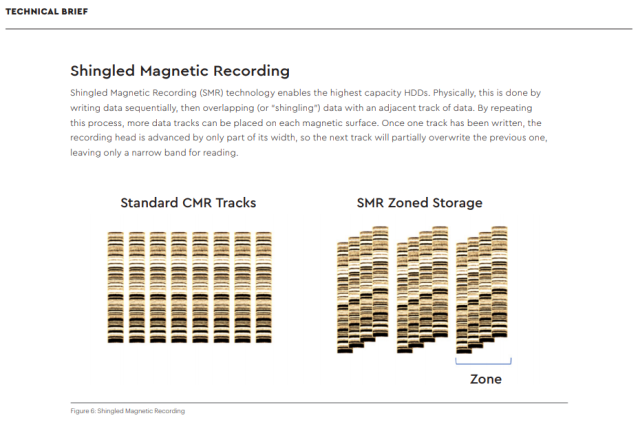Earlier this month, Western Digital announced retail availability of its Gold 16TB and 18TB CMR drives, as well as an upcoming 20TB Ultrastar SMR drive. These nine-platter disks are the largest individual hard drives widely available today.
Earlier this year, rival drive vendor Seagate promised to deliver 18TB and 20TB drives in 2020, but they have not yet materialized in retail channels. Seagate's largest drives, like Western Digital's, needed a new technology to overcome the Magnetic Recording Trilemma—but Western Digital's EAMR is considerably less-exotic than the HAMR (Heat Assisted Magnetic Recording) used by Seagate. That more conservative approach likely helped Western Digital beat its rival to market.
Understanding the Magnetic Recording Trilemma
The maximum usable data density on a magnetic recording device is limited by three competing factors. Magnetic coercivity—the strength of magnetic field required to demagnetize a domain—must be high enough to prevent the separately recorded grains from influencing one another and corrupting data. The field strength of the write head must be high enough to overcome the coercivity of the medium. Finally, the size of the field generated by the write head must be small enough so as not to overwrite adjacent areas.
In order to increase the amount of data stored in a single platter of a fixed size, you must use narrower fields—but this negatively influences the potential field strength, which in turn means that the smaller, weaker field is unable to overcome media that is sufficiently resistant to "crosstalk" between separately recorded values.
There are two basic approaches to overcoming the Magnetic Recording Trilemma as presented—you can devise a new pattern of recording that works around those limitations, or you can employ some new technology that significantly changes the relationships between the three competing factors above.
Shingled Magnetic Recording—a new pattern of magnetic writes

Shingled Magnetic Recording is a technique which takes advantage of the fact that we can reliably read data in narrower tracks than we can write it. SMR disks divide their media into separate zones, in which writes are laid down in overlapping "shingled" tracks.
While SMR techniques do increase areal density (currently, by roughly 10-15 percent) they come with significant performance and flexibility limitations. Since the write track is wider than the read track, an SMR disk cannot modify an individual sector within a zone—doing so would wipe out other sectors adjacent to the one being modified. In order to overcome this limitation, SMR disks are divided into zones, typically 256MiB in size.
There is enough linear distance between each zone and its neighbor to allow rewriting the zone as a whole upon demand—but the zone must be rewritten in its entirety. This in turn means that a single 4KiB sector rewrite may require first reading and then rewriting an entire 256MiB zone—a worst-case amplification penalty of 13,107,200 percent.
We discussed Western Digital's use of SMR at some length with Phil Bullinger, VP and GM of Western Digital's Data Center Business. Currently, there are no "hybrid" SMR drives—they're either host-managed or drive-managed, not both.
Consumer-targeted SMR disks—like the much-maligned Western Digital Red and small desktop drives from Seagate, Toshiba, and Western Digital—are drive-managed SMR. The firmware and processor on the drive itself manage aligning writes to zones, garbage collection as zones are rewritten, and everything else necessary to at least attempt to make the SMR drive perform to the levels expected to accommodate a typical consumer workload.
Enterprise-targeted SMR disks, by contrast, are host-managed. In a host-managed SMR disk, caching, zone management, and everything else necessary to optimize write patterns to the drive occurs on the host computer itself. This allows not only for larger caches but also for data optimizations further down the stack at the application level itself. If an application can deliberately produce data in 256MiB chunks rather than smaller, more random operations, its performance will skyrocket on drives with matching 256MiB zones.
Western Digital's new 16TB and 18TB Gold drives do not use SMR technology. The larger 20TB Ultrastar sibling does, and must—host-managed SMR is what allows it to eke an additional 11 percent data density out of otherwise almost entirely similar hardware.
Next-gen magnetic recording technologies: HAMR, MAMR, and EAMR
Seagate's HAMR technology uses a tiny laser to precisely heat magnetic grains before writing to them. Seagate Western Digital's MAMR trials use microwave energy to excite the precise area of the magnetic medium to be written to, making it more susceptible to change. Western Digital Western Digital EAMR is much less exotic than HAMR or MAMR—it simply applies an additional current to the main pole of the write head, as well as to the voice coil. Western Digital
The other way to potentially increase storage density is to alter the parameters of the Magnetic Recording Trilemma by introducing substantially different recording technology.
Seagate's HAMR (Heat Assisted Magnetic Recording) is one example of such new recording technology. HAMR uses a small laser to precisely heat the recording medium, temporarily reducing coercivity in an extremely small, well-defined area. The temporarily reduced coercivity allows smaller (and necessarily weaker) fields to alter that area without influencing surrounding, separately recorded areas.
In earlier research, Western Digital favored a similar technology—MAMR, or Microwave Assisted Magnetic Recording. MAMR uses a microwave emitter to excite a tiny area of the drive in order to similarly reduce coercivity to the targeted area for just long enough to perform the write operation.
Western Digital EAMR is much less exotic than HAMR or MAMR—it simply applies an additional current to the main pole of the write head, as well as to the voice coil. Western Digital The bias current applied to the main pole of the write head reduces jitter, allowing more rapid and accurate application of strong write fields. Read More – Source [contf] [contfnew] 
arstechnica
[contfnewc] [contfnewc]







